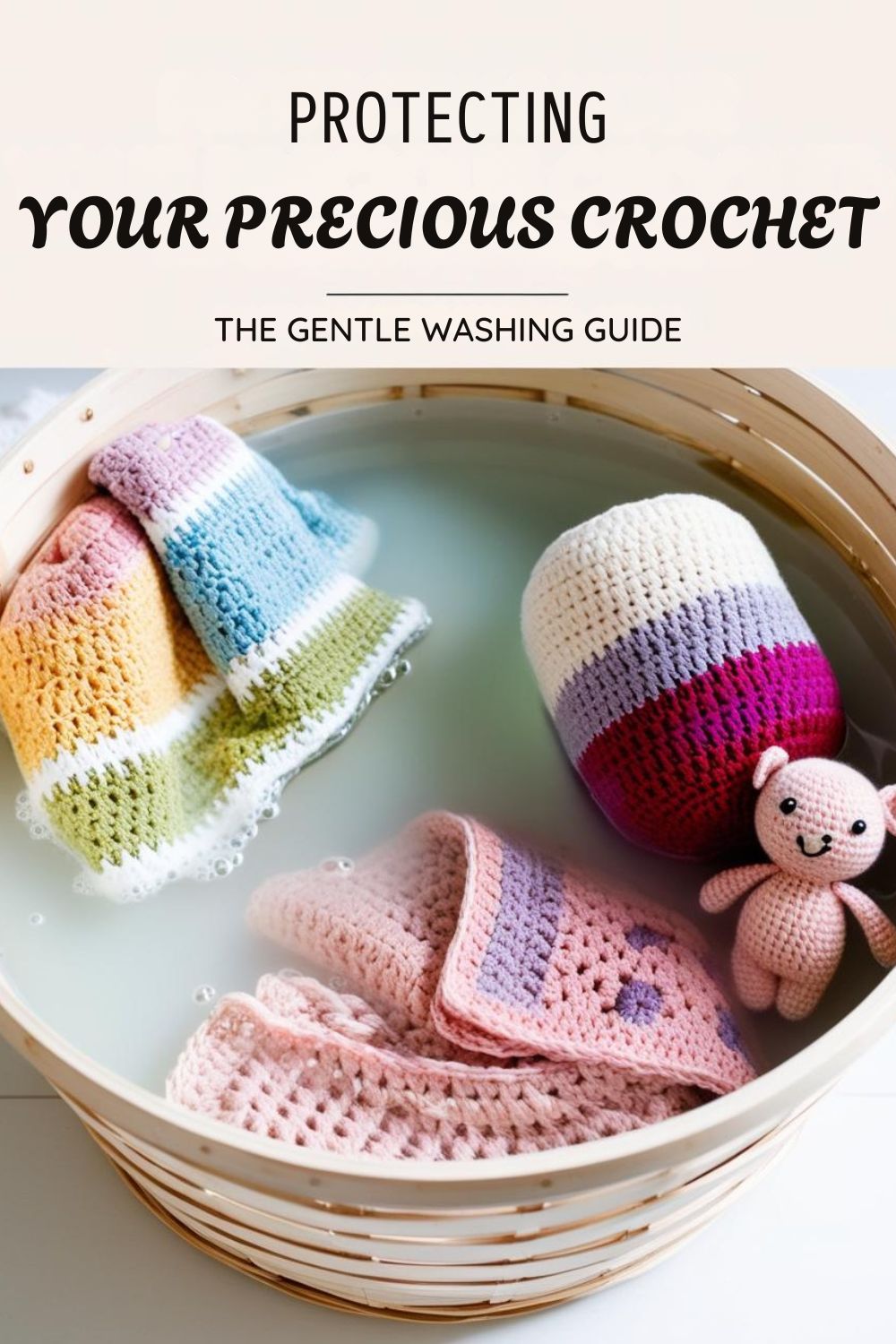
Protecting Your Precious Crochet: The Gentle Washing Guide
Protecting Your Precious Crochet: The Gentle Washing Guide
Properly caring for your handmade crochet items is key to preserving their beauty, texture, and structural integrity for years to come. These pieces aren't just textiles; they're investments of time, love, and skill. Simply tossing them into the washing machine with your regular laundry can lead to disastrous results – think shrinkage, stretching, felting, or irreversible damage. This chapter will walk you through the essential steps to gently and effectively clean your crochet treasures, ensuring they remain cherished items in your home.
Why Proper Washing Matters
Handmade crochet items are typically crafted from delicate fibers and intricate stitch patterns that require special attention. Unlike commercially produced textiles, they are more susceptible to distortion and damage from harsh detergents, hot water, and aggressive agitation. Washing them incorrectly can cause fibers like wool to felt into a stiff, matted mess, acrylic to lose its shape and softness, and cotton to shrink significantly.
Protecting your crochet is about more than just cleaning; it's about maintaining the item's original form and feel, preserving the hours of work that went into its creation. Think of this guide as your toolkit for extending the lifespan of your cherished blankets, garments, amigurumi, and accessories. By understanding the 'why' behind gentle care, you'll be better equipped to follow the 'how' and keep your creations looking beautiful for generations. It's an act of respect for both the craft and the crafter.
Essential Preparations Before You Wash
Before you even think about getting anything wet, a few crucial preliminary steps will set you up for success and help avoid potential mishaps. Skipping these could mean the difference between a beautifully refreshed item and one that's unfortunately damaged. Taking the time for these checks is a vital part of the process and should never be overlooked.
Identify Your Fiber
This is arguably the most important step. The type of yarn used dictates the best washing method and the potential risks involved. Wool, cotton, acrylic, silk, bamboo, and blends each have unique properties. Forgetting to check the fiber content is the most common mistake people make! Look for the yarn label if you still have it – it usually has care instructions. If not, you'll need to try and identify the fiber based on look and feel. Knowing your fiber is the foundation of proper crochet care.
-
Natural Fibers (Wool, Cotton, Silk, Bamboo): Often require hand washing or very delicate cycles. Wool is prone to felting with heat and agitation. Cotton can be sturdy but may shrink. Silk and bamboo are delicate and can stretch when wet.
-
Synthetic Fibers (Acrylic, Polyester): Generally more durable and less prone to felting or shrinkage, but can be sensitive to heat which can cause distortion or 'melting' of the fibers (called 'killing' in crochet/knit terms).
Expert Tip: Unsure about your yarn? If you can find a small, unneeded piece, you can test its reaction to water and detergent in an inconspicuous spot or on the yarn tail itself.
Check for Stains & Damage
Before a full wash, carefully inspect your item for any spots or stains. Trying to wash the entire piece before dealing with specific stains can sometimes set them in, making them harder to remove later. Address stains with a targeted spot treatment before submerging the whole item. Also, look for any loose ends, snags, or small holes. It's best to mend any damage before washing, as washing can sometimes worsen fragile areas.
-
Use a gentle stain remover specifically designed for delicate fabrics or a mild soap solution.
-
Apply the treatment only to the stained area.
-
Gently blot, don't rub vigorously, which can damage the fibers.
Repairing small issues proactively prevents them from becoming big problems during the agitation and drying process.
Gather Your Supplies
Having everything ready before you start makes the washing process smoother and less stressful. You don't want to be searching for a towel with dripping wet crochet in your hands!
Here’s a checklist of essentials:
-
Basin, tub, or clean sink: Large enough to fully submerge the item.
-
Mild Detergent: Specifically designed for delicate garments or wool (like Soak, Eucalan, or a gentle wool wash). Avoid harsh commercial detergents with enzymes, bleach, or brighteners.
-
Clean Towels: Several large, absorbent towels.
-
(Optional) Mesh Laundry Bag: Useful for machine washing or keeping small items together during hand washing.
-
(Optional) Blocking Supplies: Blocking mats, rust-proof pins, blocking wires (essential for shaping garments or lace).
Having these items prepared allows you to move seamlessly through the washing steps.
Choosing the Right Washing Method
Now that your item is prepped and your supplies are ready, it’s time to decide how to wash it. The golden rule for handmade crochet is almost always: gentle. While machine washing can be an option for certain fibers and items, hand washing is generally the safest and most recommended method.
Hand Washing: The Safest Bet
Hand washing provides the most control and the least stress on the delicate fibers and stitches. It’s the preferred method for items made from wool, silk, intricate lace patterns, or anything labeled as "delicate" or "hand-wash only." This method requires a bit more time and effort, but the results – a clean item that retains its shape and softness – are well worth it. It minimizes agitation, prevents stretching, and allows you to carefully handle the fabric throughout the process.
Follow these steps for a successful hand wash:
-
Fill the Basin: Fill your clean basin or sink with cool or lukewarm water. Avoid hot water, especially with wool, as it can cause felting.
-
Add Detergent: Add a small amount of mild detergent. Swish the water gently to distribute it.
-
Submerge the Item: Gently place your crochet item into the water, pushing it down until it is fully submerged and saturated.
-
Soak: Allow the item to soak for 15-30 minutes. This allows the water and detergent to work without needing excessive agitation. For lightly soiled items, less time might be sufficient.
-
Gentle Squeeze: Very gently squeeze the item under the water a few times to help loosen dirt. DO NOT WRING, TWIST, OR RUB VIGOROUSLY. This is crucial to prevent stretching and damage.
-
Drain Soapy Water: Carefully lift the item (supporting its weight) and drain the soapy water.
-
Rinse: Refill the basin with clean, cool water. Submerge the item and gently squeeze to rinse. Repeat this draining and refilling process until the water is clear and free of suds. This might take several rinses.
-
Remove Excess Water: Gently squeeze out as much water as possible without wringing. Support the weight of the wet item as it can stretch easily.
Once rinsed, it's time to move on to the critical drying stage.
Machine Washing (Use With Caution!)
Machine washing is only advisable for certain types of crochet items made from durable, non-shrinkable fibers like sturdy acrylic or some cottons, and even then, only on the gentlest settings. It is never recommended for wool, silk, delicate lace, or items with intricate details. If you choose this method, understand the risks and take precautions. It offers convenience but sacrifices the control of hand washing. Always err on the side of caution; when in doubt, hand wash.
If you decide machine washing is appropriate for your specific item:
-
Place in Mesh Bag: Always place the crochet item inside a mesh laundry bag. This helps prevent snagging on the machine drum or other laundry (if washing with anything else, which is generally not recommended).
-
Select Settings: Choose the most delicate cycle available on your machine (e.g., "Hand Wash," "Delicate," "Wool Cycle").
-
Set Water Temperature: Use COLD water only. Hot or warm water increases the risk of shrinkage and fiber damage.
-
Add Detergent: Use a minimal amount of a mild, delicate-friendly detergent.
-
Set Spin: Use the lowest spin speed or, ideally, no spin. High-speed spinning can cause significant stretching and distortion.
-
Start Cycle: Run the cycle.
-
Remove Promptly: Remove the item from the machine and mesh bag immediately after the cycle finishes to prevent creasing or setting wrinkles.
Even with these precautions, machine washing carries a higher risk than hand washing for most handmade crochet.
The Critical Drying Process
How you dry your crochet item is just as important as how you wash it. Never, ever put handmade crochet in a tumble dryer. The heat and agitation will almost certainly cause shrinkage, distortion, or felting. Air drying is the only safe method, but it needs to be done correctly to maintain the item's shape and size. Improper drying is a leading cause of crochet items losing their original form.
After gently squeezing out excess water from washing (either by hand or the lowest machine spin):
-
Remove More Water with Towels: Lay one or more clean, dry towels flat on a surface. Place the wet crochet item on top.
-
Roll: Starting from one end, gently roll the towel up with the crochet item inside.
-
Press: Gently press the rolled towel to absorb more moisture from the item. You can even step on the roll lightly. Do not wring or twist the towel roll.
-
Unroll: Unroll the towel and remove the crochet item. It should now be damp, not soaking wet.
Blocking Your Crochet
This is the ideal way to air dry many crochet items, especially garments, lace, and anything that needs to have precise dimensions or drape. Blocking allows you to shape the item, even out stitches, and encourage the fabric to lay flat.
-
Set Up Blocking Surface: Find a flat surface (floor, large table) and cover it with blocking mats or several layers of towels.
-
Shape the Item: Lay the damp crochet item flat on the surface. Gently pat and shape it according to its intended finished dimensions. Smooth out the fabric and adjust edges.
-
Pin (Optional but Recommended): Use rust-proof pins to secure the edges and shape of the item to the desired measurements. For straight edges, blocking wires can be helpful. For lace, pins help open up the pattern.
-
Let Air Dry: Leave the item undisturbed on the blocking surface to air dry completely. This can take anywhere from 24 hours to several days, depending on the fiber, humidity, and thickness of the item. Ensure good air circulation if possible.
-
Remove Pins: Once completely dry, remove the pins and carefully lift the item.
For items like amigurumi or very bulky blankets that are hard to block precisely, simply lay them flat on a dry towel or rack, turning occasionally to ensure even drying. Avoid hanging wet crochet, as the weight of the water will cause it to stretch out of shape.
Quick Tips for Different Fibers
While general principles apply, here are quick reminders based on common fiber types:
-
Wool: Use cool water and a dedicated wool wash. Minimal agitation is key. Always lay flat to dry, ideally blocked.
-
Cotton: Can handle slightly more robust washing than wool, but still best to use cool water and lay flat to dry to prevent shrinkage and stretching.
-
Acrylic: Very durable. Hand wash or machine wash on a gentle cycle in cold water. Lay flat to dry. Avoid high heat completely, as it can irreversibly damage the fibers.
-
Silk/Bamboo: Very delicate. Hand wash only in cool water with a very gentle detergent. Support the weight carefully when wet to prevent stretching. Lay flat to dry.
Understanding these fiber-specific nuances will help you choose the perfect care routine for each unique piece.
Frequently Asked Questions
Got more questions about washing your handmade crochet? Here are answers to some common queries:
1. Can I use my regular laundry detergent?
No, it is generally not recommended. Regular laundry detergents often contain harsh chemicals, enzymes, brighteners, and bleach that can strip fibers, cause colors to fade or bleed, and potentially damage the delicate structure of your crochet. Always opt for a mild detergent specifically designed for delicates, hand-washables, or wool, which are formulated to be gentle on fibers.
2. What happens if I put wool crochet in the dryer?
Putting wool crochet in a hot tumble dryer is almost guaranteed to cause felting. Felting is a process where the wool fibers lock together irreversibly due to heat, moisture, and agitation. Your soft, pliable item will shrink dramatically, become stiff and matted, and essentially be ruined. Always air dry wool flat.
3. How do I wash a large item like a crochet blanket?
Washing a large blanket requires space. You can use a clean bathtub or a very large basin. Follow the hand washing steps outlined above, ensuring the blanket is fully submerged and rinsed thoroughly (this might take several water changes). To dry, gently squeeze out as much water as possible, then lay it flat on multiple towels on the floor or a large surface, turning it periodically to help with drying. Avoid trying to hang a wet blanket, as it will stretch from its own weight. For very heavy blankets, a laundromat's large commercial front-loading machine on a gentle cycle might be considered (if the fiber allows), but hand washing is still safest.
4. How often should I wash my crochet items?
Wash crochet items only when necessary. Overwashing can lead to unnecessary wear and tear on the fibers. Garments or items used frequently might need washing more often than decorative pieces or blankets. If an item isn't stained or visibly dirty but just needs freshening, sometimes simply airing it out can be sufficient. Spot clean minor issues rather than washing the whole piece.
5. Should I always block my crochet after washing?
Blocking is highly recommended for most crochet items, especially those where shape, drape, or stitch definition is important, like garments, shawls, doilies, and lace. It helps to set the stitches, even out tension, achieve accurate sizing, and make the fabric lay nicely. For simple items like a sturdy washcloth or a dense amigurumi, laying flat to dry without pinning might be sufficient, but blocking generally improves the finished look of almost any project.
Caring for your handmade crochet doesn't have to be intimidating. By understanding the fiber, preparing properly, choosing a gentle method, and drying carefully, you can ensure your beautiful creations stay lovely for years to come. Your efforts will be rewarded with well-preserved, treasured items.
Disclaimer: Always refer to the specific yarn label's care instructions if available, as these provide the manufacturer's recommended care for that particular fiber blend.


